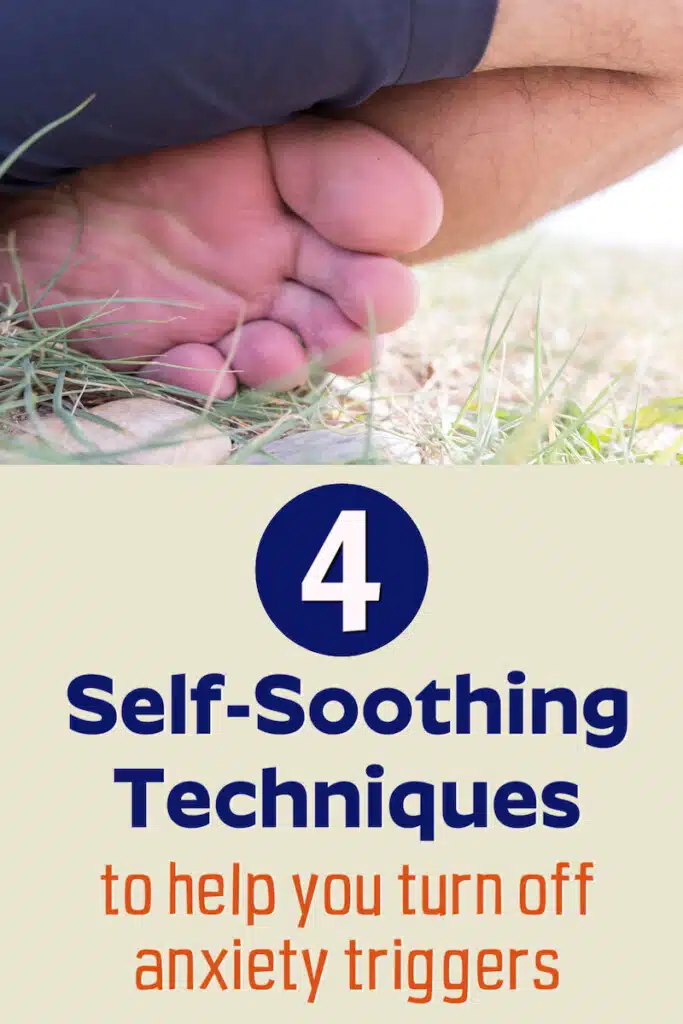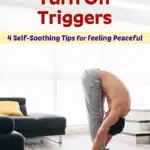Feeling peaceful in the modern world can sometimes seem daunting, especially with rising anxiety. Over 40 million adults in the US suffer from anxiety disorders, according to the Anxiety and Depression Association of America. Anxiety – a typical emotional response to stressors – will disrupt you and hinder your overall sense of well-being. Below, I’m delving into various aspects of anxiety and offering practical self-soothing tips to help you find inner calm. Later in the article, I also reveal what triggers are – and some common triggers you’re likely to encounter living in this current era.
Understanding Anxiety: Is It Neurological or Psychological?
The origins of anxiety are complex, involving a combination of neurological and psychological factors:
- Common signs of anxiety include excessive worrying, feeling tense or jumpy, irritability, difficulty concentrating, fatigue, trouble sleeping, sweating, nausea, and rapid heartbeat.
- Neurologically, the brain’s amygdala plays a crucial role in processing fear and threats. An overactive amygdala can lead to heightened anxiety responses.
- On the psychological front, early life experiences, learned behaviors, and personality traits contribute to how we experience and manage anxiety.
Understanding this interplay can help tailor treatment approaches for individual needs. For this article, though, I’ll focus more on the psychological side. These four self-soothing tips can help calm your nervous feelings and ricocheting thoughts.
1. Locate Your Center
Anxiety is often characterized by worry, unease, and fear, which can negatively affect your mental and physical health. However, it’s essential to recognize that you have the power to replace anxiety with quiet strength – through mindful self-soothing practices.
It can be helpful to imagine yourself as a spiritual being having an earthly experience. Imagine that underneath your unrest – at your deepest core – is a center of clarity.
This center of clarity is not your thoughts. It’s what witnessing your thoughts as you have them.

2. Ask Yourself, “Is It Inside My Nexus of Control?”
Perhaps ironically, one key to regaining control of your equilibrium is first acknowledging that some things are outside your nexus of control:
- Nothing can be done about things outside your nexus of control.
- So right away – at least intellectually – you can release those things you can’t control from your mind’s roster of things to tackle.
- As you get more skilled at this, you can eventually decide to place something outside of your control nexus – things you don’t want to take on, even if you could.
3. Ask Yourself, “What Previous Situation Does This Remind Me Of?
Taming the anxiety monster involves acknowledging and understanding the root causes of your anxiety.
Anxiety can stem from secret, negative beliefs or fears about the future. But even those beliefs and fears usually came from somewhere – often from past traumas or unresolved conflicts.
So, if a situation is making you anxious:
- Ask yourself, “What previous situation does this current situation remind me of?”
- And once you identify it, you can again ask, “And what previous situation does THAT previous situation remind me of?”
- And keep going back until you feel like you’re closer to the sponsoring event.
This can be helpful because it helps you realize that what’s freaking you out is not actually the thing that’s freaking you out. You’ll often feel saner and more capable as you get closer to the truth of what’s really going on.

Working with a trained therapist is usually helpful in identifying these triggers and developing self-soothing strategies to manage them.
Therapy is often successful in helping individuals reframe negative thought patterns and replace them with more balanced perspectives, ultimately leading to a sense of empowerment.
Also, sometimes, this kind of exploration can get intense, and having a therapist provide guidance and holding a safe space while you go deeper can be immensely comforting.
4. Connect to Your Breath
By cultivating a more objective awareness of your thoughts and emotions, you’re better able to shift your focus from anxiety-provoking concerns to the present moment.
Mindfulness meditation, grounding techniques, and breath awareness are effective ways to redirect your attention and find peacefulness. These are beginner self-soothing techniques you can start applying right away when feeling triggered by anxiety:
5-4-3-2-1 Grounding Technique: Name 5 things you see, 4 things you feel, 3 things you hear, 2 things you smell, and 1 good thing about yourself. This brings your mind to the present.
Mindfulness Meditation: Imagine yourself sitting peacefully on the shore of a large, lazy river on a summer evening. Clear your mind of all thoughts, but if a thought does come in, visualize placing the thought on a barge and watch it slowly float by. Just like you can categorize a barge for its cargo (the barge that carries cotton is “Textiles,” the barge that carries coffee is “Commodities,” etc.), you can similarly categorize thoughts as they float by, such as “past” and “future.”
Mindful breathing: Focus on taking slow, deep breaths. Inhale for 4 counts, hold for 2 counts, exhale for 6 counts. This oxygenates the brain and initiates the relaxation response.
More Grounding Techniques: Some people find it helpful to use a weighted blanket. Others find it useful to simply stand outside in bare feet for five minutes. The idea is to do something earthy that helps you move out of overthinking.
One of my mentors used to ask, “Where are your feet right now?” It was sort of a Jedi mind trick to snap your mind’s awareness out of negative thought and back into your physical body (when you ask yourself about your feet “in this moment,” you are suddenly aware of the bodily sensation of the soles of your feet touching the floor, or, if you’re sitting, you can wiggle your toes).
Breath Connecting: There are so many truly helpful breathing exercises! But one of the easiest is to simply become aware of the physical sensation – and sound – of your own breathing. Then, switch to nose-breathing only. Finally, try to make the exhales last even longer than your inhales. Do that for several minutes.
Common Triggers Causing Anxiety
Triggers refer to specific stimuli, situations, thoughts, or experiences that prompt or provoke feelings of anxiety or a heightened stress response in an individual. Knowing your personal triggers can help you recognize when to employ self-soothing techniques.
Common anxiety triggers include:
- Stressful events like work deadlines or financial pressure
- Interpersonal conflicts
- Health issues
- Major life changes
- Traumatic memories
Triggers vary widely from person to person, as their experiences, sensitivities, and past traumas contribute to their unique triggers.
However, mastering self-soothing skills can help individuals reverse the anxiety response when facing any trigger. Benefits include:
- Lower stress hormones
- Healthier nervous system
- Improved sleep
- Higher quality relationships
- Increased productivity
Triggers can be both internal and external:
- Internal triggers are related to thoughts, memories, or physical sensations that evoke anxiety.
- External triggers are situations or events in the environment that lead to anxiety reactions.
Identifying and understanding triggers is an important step in self-soothing.
Once recognized, individuals can work on developing coping strategies, relaxation techniques, and exposure exercises to reduce the intensity of their anxiety responses and build resilience when faced with triggering situations.
Examples of Typical Triggers In Modern Life
There are all kinds of triggers.
For example, someone with social anxiety might be triggered by the thought of attending social gatherings, public speaking, or interacting with strangers.
On the other hand, someone with specific phobias might be triggered by encountering the object or situation they fear, such as heights, spiders, or flying.
However, lately, some more common triggers for people in developed countries are driving cars, existential angst, or religious compliance.
Overcome Driving Anxiety So You Can Enjoy Being Behind the Wheel
Driving anxiety is a common manifestation of specific phobias.
If the thought of driving induces fear and panic, there are self-soothing steps you can take to overcome it:
- Gradual exposure to driving situations combined with relaxation techniques can desensitize your fear response.
- Visualizing successful and calm driving experiences can also rewire your brain’s associations with driving, turning it into a more positive and anxiety-free activity.
How to Move Beyond Existential Angst and Embrace Self-Soothing
In the quest for inner peace, one must address the existential angst that can arise from contemplating life’s meaning and purpose.
Existential angst stems from the inherent uncertainty of existence and the struggle to find significance in a vast and complex world.
To move beyond emotional turmoil and find peacefulness, consider these self-soothing steps:
Embrace Uncertainty: Accept that life’s meaning is not always clear-cut, and that’s okay. Embracing uncertainty can lead to personal growth and a deeper understanding of oneself.
Create Your Meaning: Rather than seeking a universal purpose, focus on creating your own meaning. Engage in activities that bring joy and fulfillment, aligning with your values and passions.

Practice Mindfulness: Engage in mindfulness meditation to ground yourself in the present moment. By focusing on the here and now, you can alleviate the anxiety stemming from existential pondering.
Connect with Others: Share your thoughts and feelings with friends, family, or a therapist. Connecting with others can provide valuable perspectives and a sense of belonging.
Pursue Personal Growth: Channel existential angst into personal growth. Engage in learning, explore new experiences, and set meaningful goals that contribute to your sense of fulfillment.
Remember, existential questions are a natural part of the human experience.
By confronting existential angst head-on and embracing the journey of self-discovery, you can navigate these uncertainties and cultivate a deeper sense of peacefulness and purpose.
Overcoming Religious Anxiety for a Self-Soothing Spiritual Journey
Religious anxiety arises when faith and spirituality become sources of distress rather than solace. This can stem from conflicting beliefs, fears of divine punishment, or pressure to meet certain religious expectations.
If religious expectations are causing you anxiety, reflect on your true values and spiritual needs. What brings you meaning? Then set boundaries around religious obligations that don’t serve your well-being.
Engaging in open dialogues with religious leaders or seeking spiritual guidance can help reconcile these conflicts. You can also speak with a mental health counselor to help you sort out your thoughts and feelings.
Remember, spirituality is meant to enhance your well-being, so finding a balanced perspective that aligns with your values is crucial.
Positive Signs of Anxiety Recovery: How to Know You’re Self-Soothing
As you embark on your journey toward anxiety recovery, it’s important to recognize the positive signs that indicate you’re on the right path.
These signs may include improved sleep quality, enhanced ability to manage stress, increased self-awareness, and the development of healthy coping mechanisms.
Celebrate these milestones, no matter how small they may seem, as they signify your progress in healing and finding moments of peace more often.
Mastering Self-Soothing: 4 Effective Tips to Turn Off Triggers and Find Peace
In conclusion, finding inner calm in the midst of anxiety is attainable through a combination of self-awareness, therapeutic techniques, and a willingness to explore different avenues of healing.
Learning to recognize your personal anxiety triggers and having self-soothing skills in your toolkit empowers you to reverse the anxiety response and reclaim peace of mind whenever stressful situations arise.
The key is to build awareness and have self-soothing techniques ready in your toolkit whenever triggers arise. Specifically:
- Find your calm center.
- Determine what’s in your control.
- Examine thought patterns.
- Practice mindful breathing.
Being positive and proactive in managing anxiety triggers leads down the path to greater emotional well-being and a more peaceful, meaningful life.
The journey to anxiety recovery is unique to each individual, and every step taken towards healing is a step towards a more peaceful and fulfilling life.
